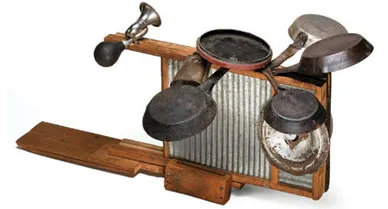Art and Soul
Bluesman Robert Young wasn’t just fooling around
/https://tf-cmsv2-smithsonianmag-media.s3.amazonaws.com/filer/object2.jpg)
To be sure, it constitutes a conversation piece. The Rube Goldberg-esque curiosity within the musical-instruments collections at the Smithsonian's National Museum of American History (NMAH) consists of two old-fashioned washboards bolted together and decked out with frying pans, a hubcap, pot lids, a wood block, a cowbell, tin plates and an old car horn with a rubber bulb. This manic, timpanic gizmo, dubbed a "full-dress" washboard by its musician creator, was the brainchild of a Philadelphia bluesman, Robert Young—a.k.a. Washboard Slim.
The washboard instrument, of course, long predates Young, who was born in 1900 and died just a few days short of his 90th birthday, not long after his final gig. It is a venerable component of American roots music, with variations that include the frattoir, a corrugated-metal breastplate often worn and played by members of New Orleans zydeco bands.
Young's innovation was to attach a board to the instrument's base, creating a kind of narrow platform. He balanced that extension on a chair and sat on it, gripping the washboard, attached at the other end of the board, between his knees. This ingenious arrangement kept both hands free, enabling Young to produce a remarkable variety of percussive sounds, the result of using everything from door hinges to thimbles as his inspired, idiosyncratic drumsticks. "Young didn't put anything on that washboard without a purpose," says Gary Sturm, the curator of musical instruments. "He was making a selection of shapes and sizes for a variety of sounds, and the selection wasn't as random as it may seem. When he added a cowbell, it had to be just the right cowbell."
Although Young's nickname may sound like the title of a new diet book and his instrument may resemble outsider art, he was an accomplished musician who played with some of the best bluesmen in the business. His colleagues included such luminaries as Brownie McGhee (with whom he recorded "Double Trouble" and "Money Spending Woman"), Big Bill Broonzy, Sonny Terry and Buddy Moss. Born in Marshall, Texas, Young moved to Philadelphia in the early 1940s, after living in the Carolinas and Virginia. In his later years, he regularly appeared at Philadelphia Mardi Gras celebrations with a local band, the Wild Bohemians. "Robert was a real gentleman," recalls Bohemian guitarist Ted Estersohn, who performed with Washboard Slim for a decade. "He had played guitar and trombone as a younger man, but at some point he'd had a stroke, which kept him from those instruments for a while, so he put together his washboard and played that for the rest of his life. But he could be surprising. At his 85th birthday party, he picked up a guitar and played just fine."
According to Estersohn, sometime in the mid-1980s Young bought more sophisticated percussion instruments, including a high-hat (two cymbals operated by a single foot pedal). "But his new gear was all stolen from the trunk of his car," Estersohn says, "so he went back to his original washboard. It was given to me after he died. The Smithsonian always seemed like the place the washboard should go."
Young, says Estersohn, died of "old age and poverty." But he was not unmourned, or unrecognized. What had been planned as a birthday bash became a memorial concert, with money raised there donated to his wife, Anna Johnson. Wilson Goode, Philadelphia's mayor at the time, declared the day of the concert, June 5, 1990, to be Washboard Slim Day.
The NMAH is closed for renovation; when it reopens next summer, Sturm plans to assemble what he calls "a wall of amazing artifacts," of which the washboard would eventually be one. That would suit Estersohn just fine. "One of the main reasons I wanted the washboard to be at the Smithsonian," he says, "is so that a kid could see it and say, ‘I could do that.' "
Owen Edwards is a freelance writer and author of the book Elegant Solutions.

/https://tf-cmsv2-smithsonianmag-media.s3.amazonaws.com/accounts/headshot/Owen-Edwards-240.jpg)
/https://tf-cmsv2-smithsonianmag-media.s3.amazonaws.com/accounts/headshot/Owen-Edwards-240.jpg)